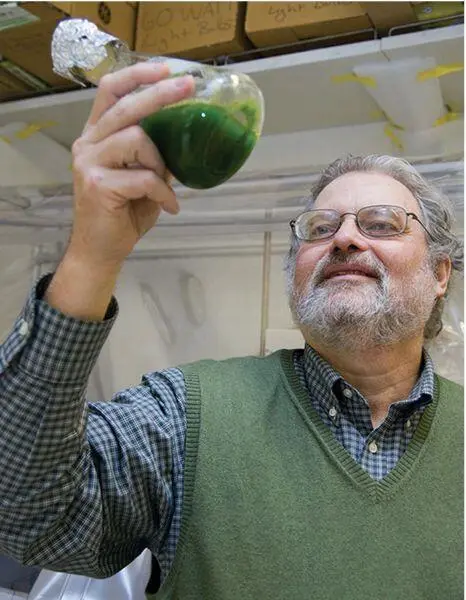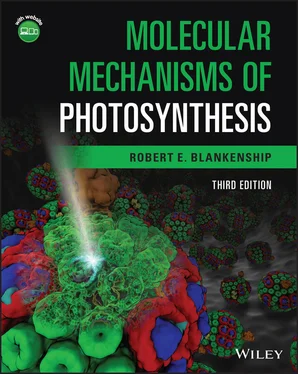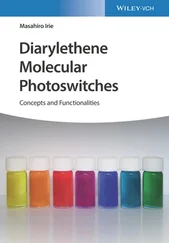Many of the concepts that we will explore throughout the bulk of this book require an understanding of basic concepts of physical chemistry, including thermodynamics, kinetics, and quantum mechanics. It is beyond the scope of our broad, and therefore necessarily brief, treatment of photosynthesis to provide a comprehensive background in these areas that form the core of the mechanistic aspects of the subject. However, some modest understanding of these physical principles is essential to be able to appreciate the essence of the photosynthetic process. This is addressed in an appendix that introduces the physical basis of light and energy. This appendix can either be read as a preface to the bulk of the book or consulted as needed as a reference.
The book is aimed toward advanced undergraduates and beginning graduate students in a range of disciplines, including life sciences, chemistry, and physics, as well as more senior scientists seeking to learn about the remarkable process of photosynthesis. An understanding of basic principles of chemistry, physics, and biology is assumed.

Robert E. Blankenship
I thank my former advisors Ken Sauer and Bill Parson for initiating me into the fascinating world of photosynthesis. Their guidance, support, and friendship have been invaluable to me during the course of my career.
I thank the many friends and colleagues from around the world for reading and commenting on some material, for helpful discussions on specialized topics, and for kindly providing figures for publication. These include (in alphabetical order) Carl Bauer, Oded Béjà, Gary Brudvig, Don Bryant, Julian Eaton‐Rye, Gyozo Garab, Govindjee, Beverley Green, Martin Hohmann‐Marriott, Werner Kühlbrandt, Haijun Liu, Yuval Mazor, Johannes Messinger, Tom Moore, Jian‐Ren Shen, and Junko Yano.
The beautiful graphic that adorns the cover of the book is courtesy of Melih Sener. This is an updated version of the graphics that were on the covers of the first and second editions.
Special thanks to my editor Rebecca Ralf and to Kerry Powell from Wiley‐Blackwell for help with the production.
Finally, I thank my wonderful family, Liz, Larissa, and Sam, for their constant love and support.
About the companion website
This book is accompanied by a companion website:
https://www.wiley.com/go/blankenship/molecularphotosynthesis3e
The website includes:
Powerpoints of all figures from the book for downloading
PDFs of all tables from the book for downloading
Chapter 1 The basic principles of photosynthetic energy storage
1.1 What is photosynthesis?
Photosynthesis is a biological process whereby the Sun's energy is captured and stored by a series of events that convert the pure energy of light into the free energy needed to power life. This remarkable process provides the foundation for essentially all life and has over geologic time profoundly altered the Earth itself. It provides all our food and most of our energy resources.
Perhaps the best way to appreciate the importance of photosynthesis is to examine the consequences of its absence. The catastrophic event that caused the extinction of the dinosaurs and most other species 65 million years ago almost certainly exerted its major effect not from the force of the comet or asteroid impact itself, but from the massive quantities of dust ejected into the atmosphere. This dust blocked out the Sun and effectively shut down photosynthesis all over the Earth for a period of months or years. Even this relatively short interruption of photosynthesis, miniscule on the geological time scale, had catastrophic effects on the biosphere.
Photosynthesis literally means “synthesis with light.” As such, it might be construed to include any process that involved synthesis of a new chemical compound under the action of light. However, that very broad definition might include a number of unrelated processes that we do not wish to include, so we will adopt a somewhat narrower definition of photosynthesis:
Photosynthesis is a process in which light energy is captured and stored by a living organism, and the stored energy is used to drive energy‐requiring cellular processes.
This definition is still relatively broad and includes the familiar chlorophyll‐based form of photosynthesis that is the subject of this book, but also includes the very different form of photosynthesis carried out by some micro organisms using proteins related to rhodopsin, which contain retinal as their light‐absorbing pigment. Light‐driven signaling processes, such as vision or phytochrome action, where light conveys information instead of energy, are excluded from our definition of photosynthesis, as well as all processes that do not normally take place in living organisms.
What constitutes a photosynthetic organism? Does the organism have to derive all its energy from light to be classified as photosynthetic? Here, we will adopt a relatively generous definition, including as photosynthetic any organism capable of deriving some of its cellular energy from light. Higher plants, the photosynthetic organisms that we are all most familiar with, derive essentially all their cellular energy from light. However, there are many organisms that use light as only part of their energy source and, under certain conditions, they may not derive any energy from light. Under other conditions, they may use light as a significant or sole source of cellular energy. We adopt this broad definition because our interest is primarily in understanding the energy storage process itself. Organisms that use photosynthesis only part of the time may still have important things to teach us about how the process works and therefore deserve our attention, even though a purist might not classify them as true photosynthetic organisms. We will also use both of the terms “photosynthetic” and “phototrophic” when describing organisms that can carry out photosynthesis. We will usually use photosynthetic to describe higher plants, algae, and cyanobacteria that derive most or all of their energy needs from light, and phototrophic to describe bacteria or archaea that can carry out photosynthesis but often derive much of their energy needs from other sources.
The most common form of photosynthesis involves chlorophyll‐type pigments and operates using light‐driven electron transfer processes. The organisms that we will discuss in detail in this book, including plants, algae, and cyanobacteria (collectively called oxygenicorganisms because they produce oxygen during the course of doing photosynthesis) and several types of anoxygenic(non‐oxygen‐evolving) bacteria, all work in this same basic manner. All these organisms will be considered to carry out what we will term “chlorophyll‐based photosynthesis.” The retinal‐based form of photosynthesis, while qualifying under our general definition, is mechanistically very different from chlorophyll‐based photosynthesis, and will not be discussed in detail. It operates using cis–trans isomerization that is directly coupled to ion transport across a membrane (Ernst et al ., 2014). The ions that are pumped as the result of the action of light can be either H +, Na +, or Cl −ions, depending on the class of the retinal‐containing protein. The H +‐pumping complexes are called bacteriorhodopsins, and the Cl −‐pumping complexes are known as halorhodopsins. No light‐driven electron transfer processes are known thus far in these systems.
Читать дальше













